Click the blue text to follow us
Bluetooth Low Energy technology is a popular short-range wireless protocol for the Internet of Things (IoT), with its most significant advantage being high energy efficiency. It is increasingly being used across various segments of IoT. The Bluetooth Low Energy Mesh Network enables various applications that were previously impossible with traditional Bluetooth technology, as it eliminates range limitations and has been recognized in multiple different environments, including industrial, agricultural, enterprise, logistics, and emerging smart cities. However, operational constraints and implementation convenience remain major challenges.

The RSL10 Mesh platform from ON Semiconductor has all the essential elements needed to develop and deploy mesh networks, empowering Bluetooth Low Energy mesh network applications in various fields such as home/building automation, smart retail, automated factories, smart agriculture, and smart healthcare, and helping to quickly move towards full deployment, pushing the limits of range, flexibility, and power budget performance.
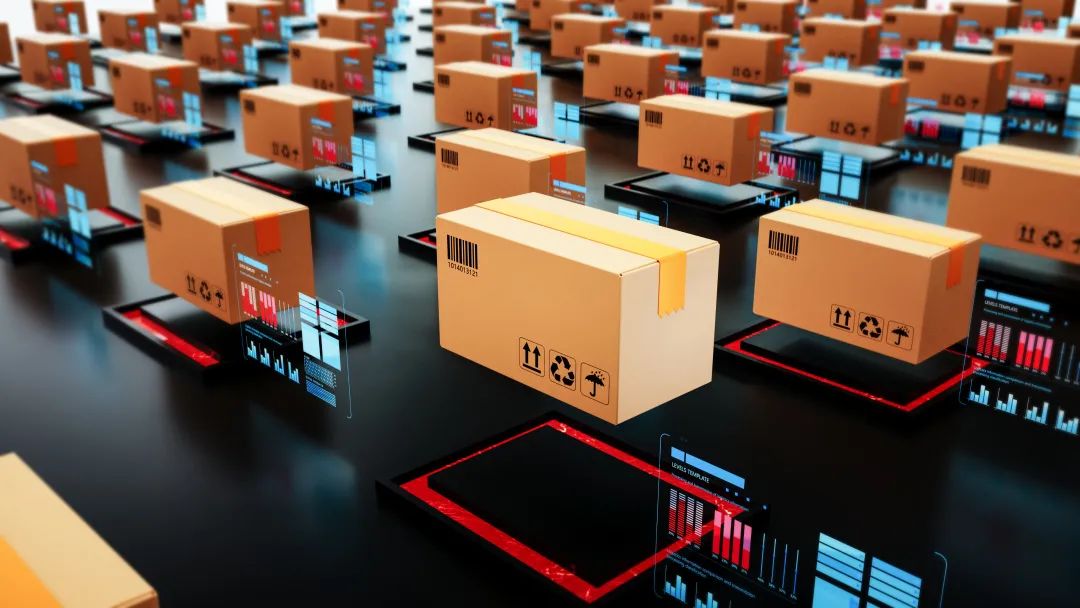
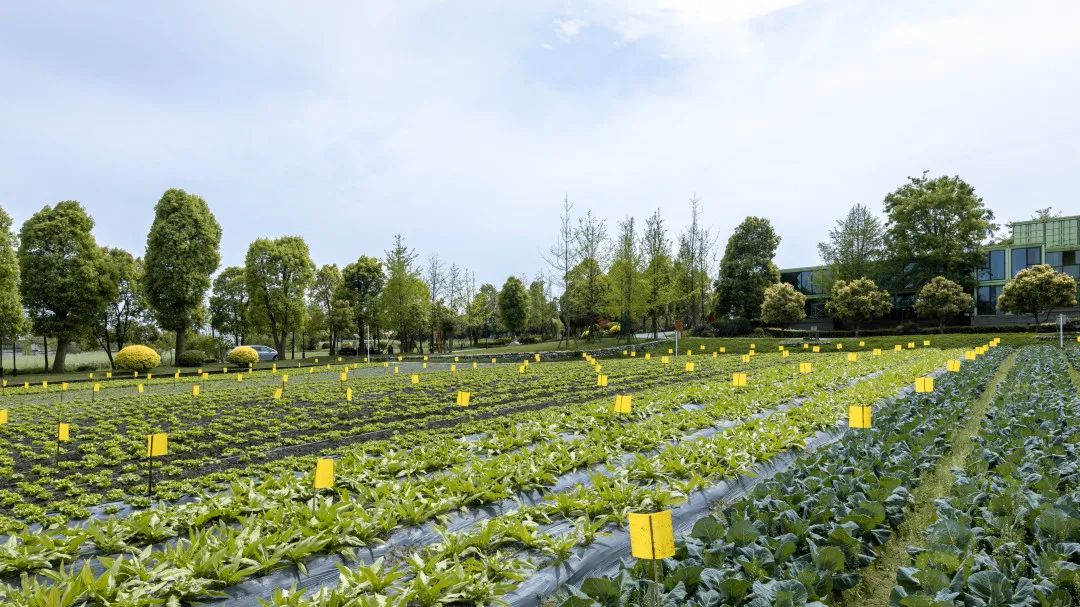
Swipe left and right to view
Advantages of Bluetooth Low Energy Mesh Networks
01
Extended Communication Range
Unlike traditional point-to-point Bluetooth connections, Bluetooth Low Energy Mesh Networks use a many-to-many topology and employ managed flooding to send data. Properly deployed Bluetooth Low Energy mesh network nodes can relay packets to target nodes beyond the transmission range, thus covering a greater distance than traditional point-to-point Bluetooth communication.
02
Flexibility
Bluetooth Low Energy employs a many-to-many topology, allowing information to reach target nodes via different paths, thus being unaffected by single point failures.
03
Secure and Reliable
The Bluetooth Low Energy mesh specification includes multi-layer encryption for security, allowing nodes in the network to relay traffic without knowing the content of any messages. Nodes can simply pass information, while potential eavesdroppers on the network can only see encrypted packets, significantly enhancing network security while retaining design simplicity.
Flexible and Easy-to-Configure Development Kit: RSL10 Mesh Platform
The RSL10 Mesh platform is based on ON Semiconductor’s ultra-low-power RSL10 System-in-Package (RSL10 SIP), which includes two RSL10 Mesh nodes, various smart sensors and indicators, and a Strata gateway for connection to Strata Developer Studio™.
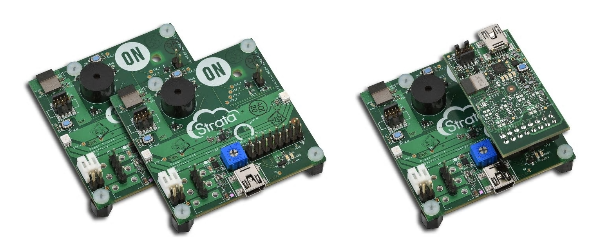
Figure: The RSL10 Mesh platform kit includes two RSL10 Mesh nodes (left) and a Strata gateway (right)
The RSL10 SIP features leading industry ultra-low power to maximize battery life. The RSL10 Mesh platform is equipped with various environmental sensors, including a temperature sensor (N34TS108), an ambient light sensor (LV0104CS), and a magnetic sensor, using an LED driver (NCP5623B) for dimming and color tuning, along with an additional vibration feedback button and a lithium battery charger (FAN54120). It also features a Wheatstone bridge for magnetic field detection based on a chopper-stabilized amplifier (NCS333) and dimming and alarm functions based on a Hall sensor, as well as a 2.3 kHz alarm.
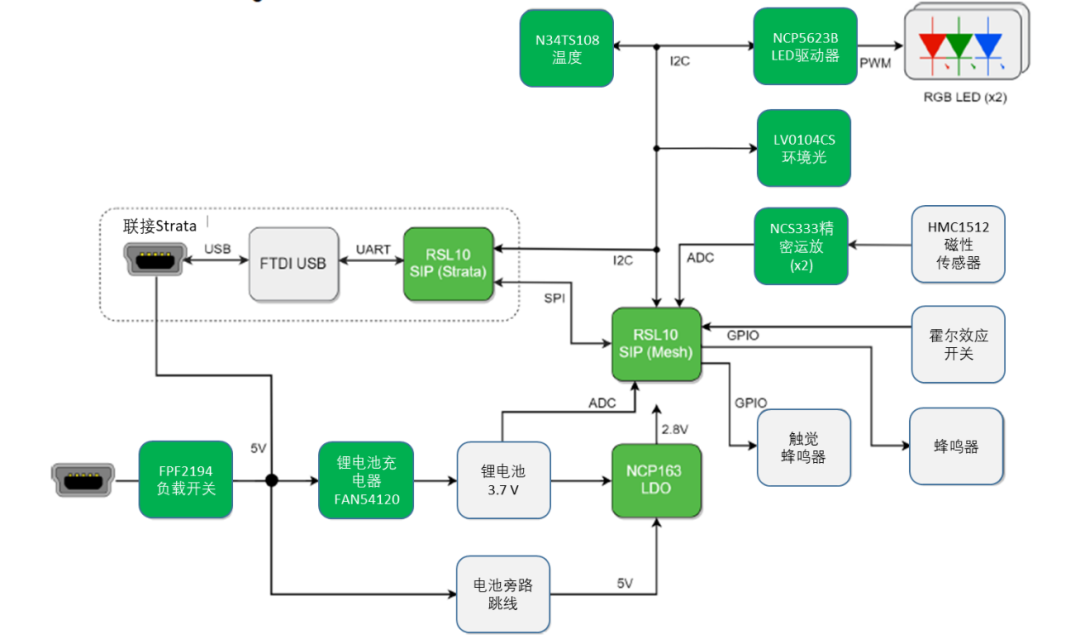
Figure: Mesh Node Block Diagram (Green box indicates products provided by ON Semiconductor)
The Strata gateway supports seamless and secure connections to Strata Developer Studio™. Strata Developer Studio™ is a cloud-connected platform that automatically identifies and downloads all documentation and supporting materials related to design and evaluation, including smart sensing, mesh relay, mesh messaging, and mesh proxy services, and supports over-the-air firmware upgrades (FOTA). In Strata Developer Studio™, designers can monitor telemetry such as node voltage, temperature, and control LED lighting, while sending and receiving Bluetooth Low Energy mesh commands. A virtual workspace is provided for common mesh network examples, including security cameras, doorbells, dimming, robotic arms, solar panels, HVAC, and virtual smart home environment nodes like doors, windows, and lighting, as well as sensor icons.

Additionally, the RSL10 Mesh platform is equipped with an Eclipse-based integrated development environment and supports FreeRTOS™ with the RSL10 software development kit, compliant with the Bluetooth Special Interest Group (Bluetooth SIG) mesh specification, and a mobile application for provisioning, configuring, and controlling low-power Bluetooth mesh networks (RSL10 Mesh Mobile App, available on Google Play or the Apple App Store) for designers to develop and expand more features.
Demonstration of RSL10 Mesh Platform Alarm and Dimming Functions
We demonstrated using the Strata-enabled RSL10 Mesh platform kit STR-RSL10-MESH-KIT-GEVK, which includes two RSL10 Mesh nodes, one Strata gateway node, three USB cables, and one rare earth magnetic ring. Each Mesh node has a 4-pin connector to choose whether to use battery power. The default setting is to use a jumper to connect the middle two pins, allowing the Mesh board to connect directly to the power network, with the USB port on the Mesh board or the Strata expansion board USB port providing 5V power. If designers wish to use rechargeable batteries, they can connect two jumpers to the top and bottom two pins, allowing battery power while the USB port can also charge the battery. Recommended battery models can be found in the list in the RSL10 Mesh platform guide.
The alarm function on the Mesh node is a simple Hall effect-based switch, which designers need to enable in the Strata kit settings. When designers place this board within the magnetic field range, the magnetic sensor will detect the magnetic field, and the alarm will not be triggered. When the charging board is removed from the magnetic field range, a network broadcast will be sent to other nodes to activate the alarm, causing all LED lights to flash red for about 15 seconds. The alarm will only be deactivated once the board is placed back in the magnetic field, stopping the flashing of all LED lights and restoring the initial settings.
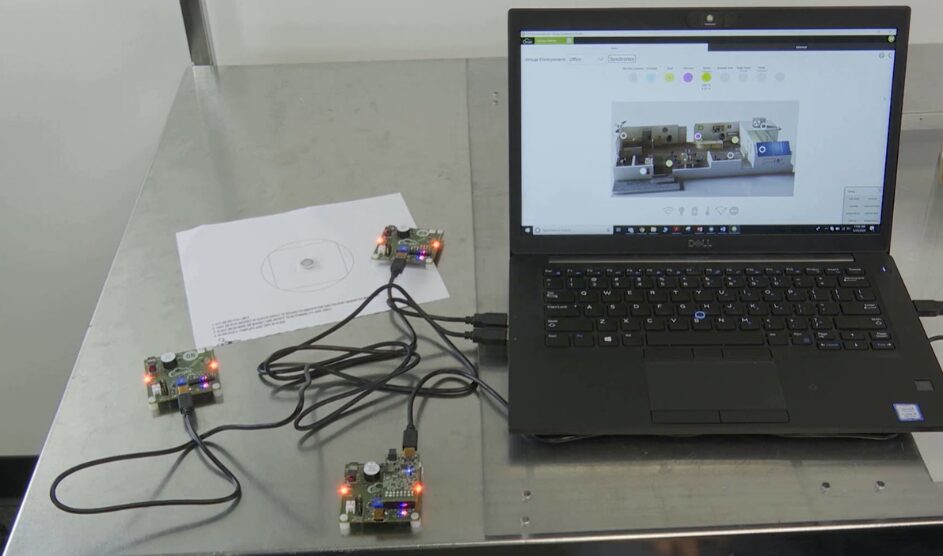
Figure: When the charging board is removed from the magnetic field range, the alarm is triggered, and all LED lights flash red for about 15 seconds
The magnetic ring included in the RSL10 Mesh platform kit is a ring magnet with upper and lower magnetic poles, and the magnetic sensor can easily detect changes in the magnetic field. Designers can place the Mesh board with the magnetic sensor above the magnet to use the dimming function. Rotate the board within a 150-degree range to adjust the brightness of the LED lights. The user’s dimming angle and the LED driver chip NCP5623B on each board determine the brightness of the LED lights. All node boards in the network share this data to adjust the brightness of each LED light.
Conclusion
Bluetooth Low Energy mesh networks extend communication range beyond point-to-point connections, are unaffected by single point failures, and include multi-layer encryption for security, enabling various applications that traditional Bluetooth connections cannot achieve. ON Semiconductor’s RSL10 Mesh platform contains all essential elements for developing and deploying mesh networks, helping engineers accelerate the development of mesh network applications based on the ultra-low power RSL10 Bluetooth 5 radio, including home/building automation, smart retail, automated factories, smart agriculture, and smart healthcare applications.
